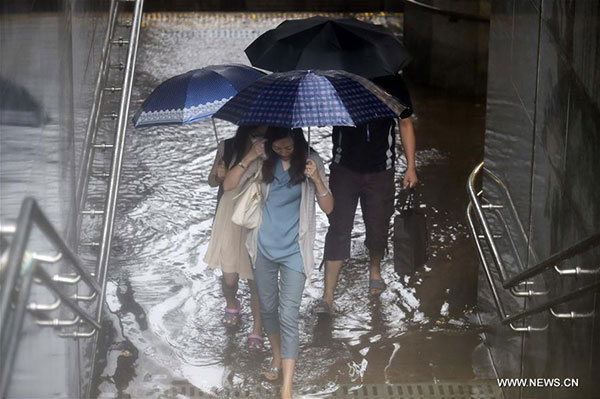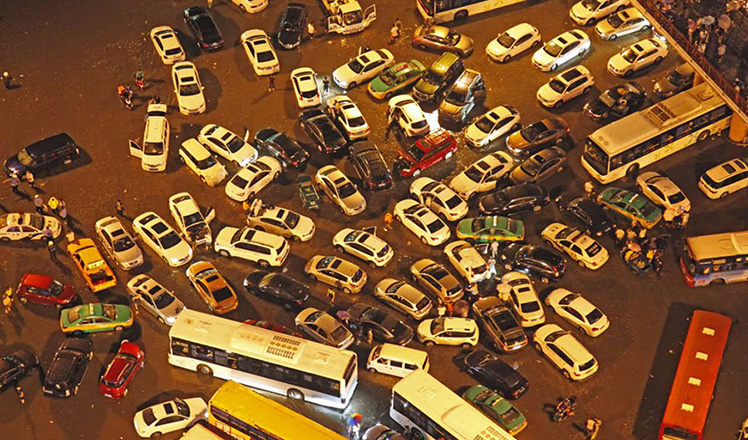Heavy downpours and ways to tackle them
Updated: 2016-07-26 07:47
By Zhang Zhouxiang(China Daily)
|
||||||||
 |
|
People walk past a flooded underground passage in Beijing, July 20, 2016. [Photo/Xinhua] |
The Beijing municipal government did a much better job of dealing with last week's rainstorm than it had done during the deluge four years ago. For instance, it sent out warnings to Beijing residents via SMS in time, as well as pressed enough police and emergency rescue personnel into service to help those in need.
But there is still room for improvement not only in Beijing but also in other Chinese cities. Some neighborhoods and streets were reportedly flooded in Beijing last week, and even though the waterlogging didn't pose a threat to people's lives, it still caused inconvenience to residents.
City administrations need to improve their planning. Some cities have already adopted some detailed measures to effectively curb waterlogging.
Manholes pose a potent threat to people when roads and neighborhoods are submerged, because their covers can be washed away by the gushing floodwaters turning them into death traps. In fact, a 21-year-old woman fell into a manhole in Changsha, Central China's Hunan province, in March 2013 and her body was found only after two months.
After that tragedy, Changsha started installing net covers on manholes. Made of nylon and nailed to the inner surface of the manholes, each net can bear a weight of up to 600 kilograms. As they say, it's better to be safe than sorry.
Some of the underground interchanges in cities have been built in low-lying areas and however hard the government tries it is not possible to prevent them from flooding during heavy downpours. To prevent drivers from driving into flooded underground interchanges, Nanjing, East China's Jiangsu province, worked with domestic navigation company Amap to mark all the flood-prone roads on the city map in July last year; the information is disseminated by the traffic police and updated in a timely manner. The traffic authorities have enough data on which underground interchanges is waterlogged and all they need to do is to share the information with navigation companies.
Since the measures taken by Changsha and Nanjing can go a long way in saving lives during heavy downpours, other cities would do well to emulate them.
Besides, the city authorities in Guangzhou, South China's Guangdong province, have implemented a special measure to increase the permeability of ground surface. According to a regulation issued in 2014, when real estate developers fill up land for construction of buildings, they have to choose materials that allow rainwater to flow down to the underground water table; the permeability rate of the outdoors has to be at least 40 percent and that of parking lots and walkways at least 70 percent.
Since then, developers in Guangzhou have been using bricks with a hole in the middle in newly built communities to allow rainwater to flow down to the ground instead of running off into drains and roads and flooding them.
In Fuzhou, South China's Fujian province, developers have dug "green spaces" in newly built neighborhoods to enable rainwater to flow into them and seep under ground.
These are lessons for other Chinese cities, and by following them, especially during thundershowers, they can make people's life more convenient.
The author is a writer with China Daily. zhangzhouxiang@chinadaily.com.cn
- The world in photos: July 18-25
- Cambodia hailed for upholding justice on maritime issue
- ASEAN countries urged to 'dispel disruptions'
- One dead, 12 injured in blast near Nuremberg, Germany
- Fashion of Queen Elizabeth on exhibition in London
- Hollande urges Britain to begin EU exit talks 'as soon as possible'

 Sunny images of 60-year-old go viral in China
Sunny images of 60-year-old go viral in China
 Xi'an battered by summer downpours
Xi'an battered by summer downpours
 Photographer uses traditional technique to capture images
Photographer uses traditional technique to capture images
 Now and then: Rebirth of Tangshan 40 years after quake
Now and then: Rebirth of Tangshan 40 years after quake
 Things you may not know about Major Heat
Things you may not know about Major Heat
 Unveiling the secrets of Elizabeth II’s wardrobe
Unveiling the secrets of Elizabeth II’s wardrobe
 Go global: Wanda's top 10 foreign acquisitions
Go global: Wanda's top 10 foreign acquisitions
 Hot pepper and ice tub challenge held in E China
Hot pepper and ice tub challenge held in E China
Most Viewed
Editor's Picks

|

|

|

|

|

|
Today's Top News
Ministry slams US-Korean THAAD deployment
Two police officers shot at protest in Dallas
Abe's blame game reveals his policies failing to get results
Ending wildlife trafficking must be policy priority in Asia
Effects of supply-side reform take time to be seen
Chinese State Councilor Yang Jiechi to meet Kerry
Chinese stocks surge on back of MSCI rumors
Liang avoids jail in shooting death
US Weekly

|

|








